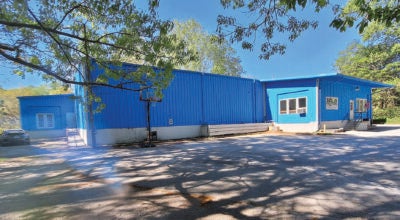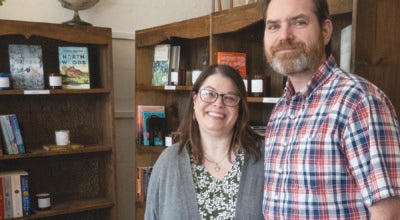Saluda ordinance back to planning board
Published 6:01 pm Wednesday, January 19, 2011

Saluda resident Bruce Campbell displays photos of a property in his neighborhood which includes a home occupation he believes has negatively affected property values in the neighborhood. Shown behind him are commissioners George Sweet and Johnnie Kinard. (photo by Samantha Hurst)
City leaders debate home occupation definition
Saluda commissioners tabled a vote Monday, Jan. 17 to change the definition of “home occupation” within the city’s zoning ordinance after residents and city leaders raised a host of concerns over alterations proposed by the planning board.
Resident Dotty Eargle said she adamantly believed Saluda should not restrict home occupations.
“In this period of ungodly economic times, people are having home occupations to make money because they need it – bad,” Eargle said. “If people buy property, they have certain rights and I think you are infringing on their rights.”
Bruce Campbell disagreed.
“I fully believe in supporting our entrepreneurs, but what about when the work you do destroys the property next to you?” Campbell asked. “All I’m trying to do is protect our property. I just wish the commission and everyone would consider what this means to people that live in R1.”
Saluda’s zoning ordinances currently define a home business or occupation as:
“Any use conducted entirely within a residence, its yard, and any accessory buildings and carried on by the occupants thereof, which use is clearly incidental and secondary to the use of the building for residence purposes and does not change the character thereof. In connection with said use there shall not be more than one person not a resident on the premises who is employed specifically in connection with the home business or occupation. No mechanical equipment shall be installed or used on the premises except that which is normally used for domestic or professional purposes, and not over twenty-five percent (25%) of the total floor space of the principal building shall be used for home occupations.”
Campbell and other residents wanted to see this definition clarified and strengthened.
Planning board chairman Henry Bright said board members aimed to think long-term when making changes.
“I think when the planning board took a look at what will Saluda look like in 10 years… we wanted to limit the number of accessory buildings on lots first of all, in an effort to maintain the look and feel of the community,” Bright said.
Bright said the Polk County definition includes phrases related to neighbors not being able to see, smell or hear anything related to the home occupation. Therefore the business must be “contained within the residence,” Bright said.
According to alterations the planning board suggested, residents with home businesses must conduct said business within the four walls of the residence and one additional accessory building on the property.
Taking these things into consideration, planning board members recommended the ordinance definition read:
“An occupation, profession, activity or use that is clearly a customary, secondary, and incidental use of a residential dwelling unit which does not alter the exterior of the property or affect the residential character of the neighborhood.”
They also suggested it include a number of provisions.
Those provisions said signage is restricted to one sign up to 1 square foot for a home occupation and a separate sign, up to 1½ square feet, to identify a residence. The provisions also included that storage of materials, equipment, displays or other visual evidence of a home occupation is not permitted except within the primary dwelling and in one fully enclosed accessory structure.
The home occupation can employ no more than one person who is not a family member living in the residence and no more than 25 percent of the residence and one accessory building can be used for the home occupation, according to the suggested changes. They also said that vehicles used in conjunction with, and parked at, any home occupation cannot exceed the number typically expected in a neighborhood.
Mayor Fred Braisden seemed increasingly concerned about the impact changes in the zoning ordinance might have on the ability of residents to later sell their property.
He pointed out a local artist as an example. The artist currently has three accessory buildings on his property. Should that artist choose to move and not conduct his personal business there for a period of 120 days, he would no longer be able to sell the property to someone intending to use it for the same purpose.
The way the zoning currently reads, there is no limitation to the number of accessory buildings allowed.
Commissioner Johnnie Kinard wanted to know how portions of the ordinance would be enforced.
“Who’s going to determine what an acceptable vehicle is?” Kinard asked. “That section is entirely too vague; it has to be a lot more specific.”
Saluda Attorney Bailey Nager expressed concern over the ability to enforce the vehicle restrictions as well.
Other issues raised included the inclusion of commercial historical or CH zones in the home occupation ordinance. Commissioner Leon Morgan said he would hate to see the mess the town would face were that zone included in the home occupation codes. The commercial historical or CH district includes downtown Saluda.
Bright said leaving CH in the ordinance language was simply an oversight. He said the board had no intention of trying to impose home occupation regulations on commercial property; they were intended only for residential areas.
City clerk Doris Marion also read a letter from resident Nancy C. Johnson, who could not be present.
“Every time I leave my home I’m exposed to three sides of my neighbor’s property, which looks like a trash pile,” Johnson wrote.
Johnson asked the commission to approve the ordinance so other residents didn’t have to deal with a similar sight around their property.
City leaders said they received 11 other letters, all in favor of the proposed changes.
Lynn Cass, chairman of the Historical Saluda Commission, spoke to encourage the passing of the new definition.
“Our neighborhoods are our future,” Cass said. “I think it’s very important to have strong zoning for our community.”
The board will now take commissioners’ requests back and attempt to rectify concerns over verbiage related to vehicles, the creation of a sliding scale for determining the number of accessory buildings allowed based on lot size and the elimination of CH zones from the definition.
Planning board members reiterated that no one currently holding a home occupation license would be affected under the new definition. Changes to the zoning code would affect only residents seeking a home occupation license after the commission approves the ordinance.





